Deborah Swift's Blog, page 38
October 19, 2013
The Historical Novella - Tips from Helena P. Schrader
As you might have noticed, my blog has transferred itself to my brand new website. For the moment I am linking to it from here too, but I hope you will follow me on the new site - click below for the link to Helena's post on Novellas.
http://riddleofwriting.deborahswift.com/2013/10/19/the-historical-novella-tips-from-helena-p-schrader/
Thank you for following me!
http://riddleofwriting.deborahswift.com/2013/10/19/the-historical-novella-tips-from-helena-p-schrader/
Thank you for following me!
Published on October 19, 2013 04:55
September 23, 2013
Sizergh Castle, Cumbria - ghosts and old glories #EHFA
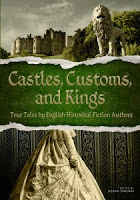 In order to celebrate the launch of Castles, Customs and Kings I'm taking part in a "blog hop" . You can go to English Historical Fiction Authors blog to enter for a chance to win a free copy!
In order to celebrate the launch of Castles, Customs and Kings I'm taking part in a "blog hop" . You can go to English Historical Fiction Authors blog to enter for a chance to win a free copy!I am also giving away a brand new signed paperback copy or ebook of my 'not-quite-released-yet' novel - A Divided Inheritance! Book will be shipped as soon as it is available, launch date 23 October. Comment under the post to enter. Extra entry if you join the blog. Don't forget to leave an email address.
The name Sizergh dates from the 9th century and was originally spelled sigaritherge, meaning Sigarith's pasture (sigarith is a female name.)
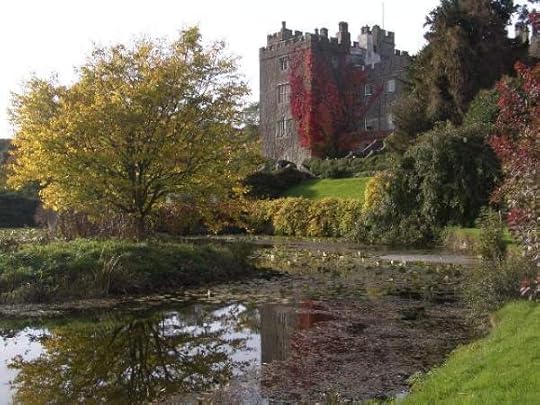
The castle has been home to the Strickland family for many generations, beginning in the 12th century, and is still lived in by them today. During the Wars of the Roses the family were Yorkists, and in the succeeding generation were linked with the Parres of Kendal - the family of Catherine Parr, wife of Henry VIII.
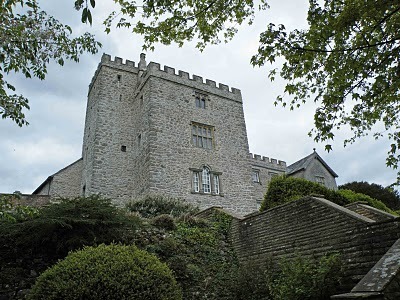
The photos above and below are from an article on the castle by Matthew Penmott, and I can heartily recommend his site on the Castles of Cumbria.
 The Strickland Arms in the Parish Church, KendalSizergh Castle consists of a Pele tower dating from the 14th century, which gave protection against scottish raiders. On the courtyard front is the Strickland Coat of Arms. The main entrance leads today into a Tudor Great Hall, which has since been adapted by different generations of the family into a series of smaller rooms. An Elizabethan corner block and wings enclose a courtyard, and on three sides of the castle the remains of a moat is discernible.
The Strickland Arms in the Parish Church, KendalSizergh Castle consists of a Pele tower dating from the 14th century, which gave protection against scottish raiders. On the courtyard front is the Strickland Coat of Arms. The main entrance leads today into a Tudor Great Hall, which has since been adapted by different generations of the family into a series of smaller rooms. An Elizabethan corner block and wings enclose a courtyard, and on three sides of the castle the remains of a moat is discernible.The Return of the Inlaid Chamber
In 1891 the ornate panelling from the Inlaid Chamber, along with various furnishings, was sold to keep the house maintained. Thanks to the Victorian and Albert Museum, the original panelling and stained glass which was tailor-made for this room at Sizergh has now returned home to the castle after more than a century in London, and is now on permanent loan. (Pictures from the V&A)

The beautifully wrought panels were inlaid with English Poplar and “Bog” Oak to create a three dimensional effect of geometric and strapwork motifs.
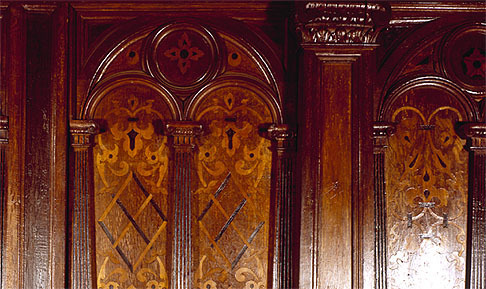
Ghost of the Starved LadyIn the Pele tower ghostly sobs denote the presence of a lady whose husband, before a raid by the Scots, was locked away in a room with an impregnable door - presumably to keep her safe. But her husband died and the terrified servants abandoned the place. The poor wife starved, and as she tried to claw her way out she went slowly mad. Her screams still haunt Sizergh on dark and spooky nights......

More photos of ghosts can be found at http://www.strangerdimensions.com/2013/07/11/top-10-famous-ghost-pictures-and-the-stories-behind-them/
Apart from the attraction of the ghost, Sizergh Castle is managed by the National Trust and is well worth a visit - beautiful grounds and gardens too, along with more than a thousand years of history!
Published on September 23, 2013 01:29
September 13, 2013
Robin Hood - the anti-hero for today as discovered by Lauren Johnson
Today I'm welcoming Lauren Johnson to talk about her new debut, The Arrow of Sherwood. I have always been fascinated by Robin Hood, so I asked Lauren -
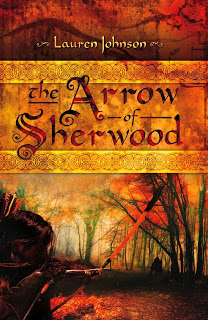 Why do you think the legend of Robin Hood has been so enduring?
Why do you think the legend of Robin Hood has been so enduring?Lauren : I think Robin endures because he is an antihero – throughout his history, from at least the fifteenth century, he has been a symbol of misrule, of chaos, sometimes of outright violence and lawbreaking. His connection with Mayday in the past is a clear sign of that, because May was all about raucous celebration and upsetting the norm. But he is also a very modern hero. You can see that in the Robin Hood tax campaign – we still want a figure who stands up for the poor and needy, against the seemingly all-powerful wrongdoer. In all our modern TV detective shows, the main character could almost be Robin Hood – they do what they have to, to bring down the bad guy, even if it means bending the rules. He’s mischievous, but he stands for something, and that’s really appealing.
What will surprise the reader about your version of the character of Robin Hood, and will we be meeting Maid Marian?
In The Arrow of Sherwood you will meet pretty much all the archetypes of the Robin Hood story, but probably not in the way you expect. At the start of the book Robin comes back from crusade – he was sent on it to do penance – and the first person he meets is called Marian Peverill. They are supposed to get married, in one of the usual noble arranged marriages, but they deeply dislike each other. There is no respect between them whatsoever. That scene was one of the first I had in my mind – these two famous romantic characters appearing, and they can barely tolerate being in the same courtyard.
I wanted to make Robin, like all the characters, just a bit more human than in lots of versions of his story. He has grown up as a lord’s son but he feels constrained by his family and spent lots of his youth around lowborn men – there’s a bit of a Henry V element to him in that respect. But returning from crusade he is supposed to give up his ties to the common friends he had, and properly become a lord, ruling over them, focusing on increasing his estate and keeping the law. So a lot of the book is about that struggle: between being the lord his family want him to be, and his instinct to help his old friends. Not just because he feels that some other lords are abusing their power and he ought to stop it, but also because there is that danger-seeking element to him that enjoys transgressing rules.
You work as a costumed interpreter, can you explain what this is and how this helps your understanding of history?
Costumed interpretation – sometimes called live or historical interpretation – is a combination of dramatic performance, historical presentation and one-on-one conversation, usually in heritage settings. At its simplest, it means I wear a costume and engage with the public as a character from the past. I have been very lucky to work in a wide range of time periods, portraying very different – but always interesting – characters. I’ve played everyone from medieval princesses to Victorian scullery maids.
I think my experience as a costumed interpreter has helped me massively, not only in my understanding of the past but in my story telling. As part of my research I often go beyond reading about historical events and my character to learn songs, dances, social behaviours, contemporary stories – some of which are pretty weird – and that means I get a really rounded view of the past. Then, having done my own research I have to impart that knowledge to members of the public, from toddlers who might just want to know about medieval animals or my crown, to hyper-informed professors in their 60s. You get very good at gauging what interests the public and the best way of getting your information across.
And then there is simply the fact that I’ve been in the really privileged position of running up and down castle stairs in flat leather shoes, felt how you move in a laced gown with really long beautiful sleeves that can trip you up, sat in a medieval great hall and watched recreated court cases or stories being told – I’ve even shot a trebuchet in my time and withstood a siege from the castle walls. (Not literally, I hasten to add.) When you have the physical experience of a period of history and you’re engaging with your character, you get very close to feeling like you are back in that era, and I think it helps you understand their behaviour.
How important is the real-life history to your re-telling of the story and what is the favourite source you have used?
For me, the real-life history is very important. Obviously, I’ve written a story about a man who almost certainly didn’t exist in the way his myth is now remembered. But I very much wanted to root my version of Robin Hood in a real world – a period that I had spent a number of years researching and interpreting.
I came at this story with a clear question in my mind. A lot of the popular mythology of Robin Hood has ossified over the years – we think of him being a nobleman who lives in the forest with his common friends and Maid Marian, who helps King Richard against evil Prince John and steals from the rich to help the poor. But that character doesn’t really make sense in the twelfth century, when Richard and John existed. Noblemen were usually very separate from the people on their land, and you didn’t get noblewomen hanging out in forests with paupers. So my question was: If a nobleman called Robin of Locksley had existed in that era, how might he have become the Robin Hood we recognise today? I wanted to fuse the historical fact with that myth.
In terms of research, my favourite sources are contemporary ones that bring the past to life. I love twelfth century stories – Marie de France, Chrétien de Troyes, the moral fables. And I really like visual sources. I would love to take more time to just sit and look at manuscript images, because they are extraordinary, and they reveal so much about medieval life and their sense of humour. It’s a later document than my story is set but the Luttrell Psalter of about 1320-40 is brilliant from that perspective – it’s full of scenes of medieval noble life, like the lady sending her husband off to war and handing him his armour, or feasts being served at great tables, or royal ladies on the move, with an absurdly long wagon and all their servants and animals. Those sources bring the past to life, and make your realise that they were still human beings – it bridges the gap between us and them, and that is always what I want to do in my work.
Thanks Lauren, I've loved talking to you - and all the best with The Arrow of Sherwood.
You can follow Lauren on Twitter @History_Lauren or visit her website at http://laurenjohnson1.wordpress.com
Published on September 13, 2013 15:08
September 9, 2013
The Renaissance Theatre and murder - the Next Big Thing by Gabrielle Kimm
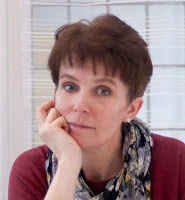 I'm totally thrilled to welcome Gabrielle Kimm, author of His Last Duchess and The Courtesan's Lover to tell us about her Next Big Thing - a game I was nominated for by Helen Hollick.
I'm totally thrilled to welcome Gabrielle Kimm, author of His Last Duchess and The Courtesan's Lover to tell us about her Next Big Thing - a game I was nominated for by Helen Hollick.I'm a big fan of Gabrielle's page-turning books, so here are her answers to the next big thing questions.
1) What is the working title of your next book?
It’s now a fixed and final title! It’s called ‘The Girl With The Painted Face’.
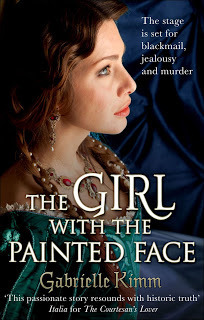
2) Where did the idea come from for the book?
My publishers told me that they were keen for me to write another novel set in Renaissance Italy, as the two previous books (His Last Duchessand The Courtesan’s Lover – both set in that era) have been selling quite nicely so far. As a trained drama teacher, I had been interested in writing a book about actors for some time, but had presumed that it would be difficult to come up with a sensible central female character, if women’s parts in plays at that time were always taken by boys. (Other than the ‘girl pretends to be boy to learn to act and then the truth of her identity is discovered’ scenario, there didn’t seem to be much opportunity for an original story. But then in the course of researching, I came across the biography of an amazing woman called Isabella Andreini – a consummate Renaissance actress and a writer of some distinction – and discovered, much to my surprise and delight, that in Europe, unlike in Puritan Britain, women were as numerous and as successful as men on the stage. It was an exciting discovery! The aforesaid Isabella makes a cameo appearance (as herself!) in my story.
3) What genre does your book fall under?
Historical Fiction.
4) What actors would you choose to play the part of your characters in a movie rendition?
Oh, this is such a difficult question! (I’m not that clued up about young actors at the moment ...) There’s a very pretty girl called Jenna Louise Coleman, who I think would be rather good as my lovely Sofia, and as for my central male character, Beppe Bianchi ... oh, that’s hard. Beppe’s an actor, a tumbler and a juggler – he’s quirky and funny and tall and leggy ... the closest I can get is a much younger David Tennant (Beppe is only twenty-three). But even the adorable Mr Tennant is not quite right. I’d need to spend time ploughing through ‘Spotlight’ (directory of actors) to find the right person, I think! There are parts in the story which could happily be played by Jude Law, Simon Callow, David Suchet and ... oh, possibly Alex Kingston – but you’ll have to read it to find out which parts!
5) What is the one-sentence synopsis of your book?
Seventeen-year-old seamstress, Sofia, adopted by an anarchic troupe of travelling actors, is wrongly accused of murder; a catalogue of misunderstandings and deliberate deceptions threaten her future happiness.
6) Will your book be self-published or traditionally published?
Traditionally – like my other two novels, it will be published by Sphere, an imprint of Little, Brown (in November 2013).
7) How long did it take you to write the first draft of the manuscript?
Rather terrifyingly, I was given just over a year to complete the first draft to a standard fit to be handed in. Each of my previous books having taken the best part of three years to write, this was something of a challenge! I did manage to make my deadline, but only just!
8) Who or what inspired you to write this book?
As I’ve said, I was originally inspired by the discovery of the extraordinary Isabella Andreini (who amongst her many, many achievements, could improvise in front of a paying audience ... in rhyming verse!!), but that then sparked a desire to write about the buzzing and exciting world of theatre. I’m teaching in a small performing arts school at the moment, so I regularly spend a couple of days a week surrounded by ‘the buzzing and exciting world of theatre’ – perhaps it’s not that surprising that I’ve been wanting to write about it!
9) What else about the book might pique the reader’s interest?
The story centres around this troupe of travelling Commedia dell’ Arte actors. The traditions of Commedia dell’Arte are totally fascinating, and they’re alive and well in the modern world! (I’ve had the best fun researching - including practical acting workshops with a modern troupe – the Rude Mechanical Theatre Company - so that I could learn to move and stand like a real commedia actor.) Although never formally adopted in Britain, commedia traditions have in many ways filtered down into our own modern theatrical inheritance, from people like Charlie Chaplin, through to (surprising though it may seem ...) The Simpsons! Commedia is a comedy of archetype – it sets up recognisable pastiches of types of individuals, and then makes sure that the ‘little man’ wins out over authority and pomposity.
I’m also bringing out a little ebook ‘prequel’ in October – like an appetite whetter for the main novel. It will be called ‘Playing a Dangerous Game’ and will be on Kindle for 99p. It’s 12,000 words long – so perhaps more of a long short story than anything else, and it features my central character, Sofia, in a self-contained story, which leads into the beginning of ‘The Girl with the Painted Face’.
Now, let me introduce you to a couple of my writer friends. I live and work in rural West Sussex, and am lucky enough to have two other novelist friends living nearby. Isabel Ashdown and Jane Rusbridge and I all met through the MA in Creative Writing course at the university in Chichester, and we now do lots of author gigs together, both locally and further afield, under the banner of ‘The Three Sussex Writers’. Jane and Isabel are wonderful writers, and I feel very fortunate to be able to work with them regularly.
Take a look at their web sites:http://isabelashdown.comhttp://www.janerusbridge.co.uk
Thanks Gabrielle - all the best with Playing a Dangerous Game and The Girl with the Painted Face. www.gabriellekimm.com
Published on September 09, 2013 01:47
September 2, 2013
A Divided Inheritance - there's nothing like a real book
I can't tell you how thrilled I am to receive the advance readers copies of A Divided Inheritance, which are in fact exactly what will go on sale in the shops in two months time. I'm a complete book junkie in terms of the texture and feel of a book and this one looks wonderful with its textured gold and white writing. The back of the book looks great too. Pan Macmillan have done a lovely job inside and out and I'm so proud of it!
It was a monster of a book to research, but I loved every minute and look forward to taking my readers on a thrilling journey from Jacobean London to Golden Age Spain.

I'm on a tour of the blogosphere on its release so copies just like these (or the electronic equivalent) will be winging their way out for review to bloggers shortly. You can find out where I'll be touring by clicking on the tour banner. Some of the tour hosts will be offering Giveaways. There are a few extra copies too so if you'd like to review a copy for your blog, do get in touch.
A family divided by fortune. A country divided by faith.
London 1609…
Elspet Leviston’s greatest ambition is to continue the success of her father Nathaniel’s lace business. But her dreams are thrown into turmoil with the arrival of her mysterious cousin Zachary Deane – who has his own designs on Leviston’s Lace.
Zachary is a dedicated swordsman with a secret past that seems to invite trouble. So Nathaniel sends him on a Grand Tour, away from the distractions of Jacobean London. Elspet believes herself to be free of her hot-headed relative but when Nathaniel dies her fortunes change dramatically. She is forced to leave her beloved home and go in search of Zachary – determined to claim back from him the inheritance that is rightfully hers.
Under the searing Spanish sun, Elspet and Zachary become locked in a battle of wills. But these are dangerous times and they are soon embroiled in the roar and sweep of something far more threatening, sending them both on an unexpected journey of discovery which finally unlocks the true meaning of family . . .
A Divided Inheritance is a breathtaking adventure set in London just after the Gunpowder Plot and in the bustling courtyards of Golden Age Seville.
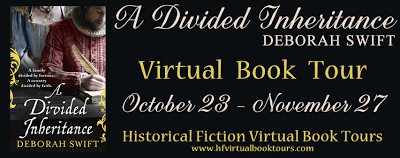
It was a monster of a book to research, but I loved every minute and look forward to taking my readers on a thrilling journey from Jacobean London to Golden Age Spain.

I'm on a tour of the blogosphere on its release so copies just like these (or the electronic equivalent) will be winging their way out for review to bloggers shortly. You can find out where I'll be touring by clicking on the tour banner. Some of the tour hosts will be offering Giveaways. There are a few extra copies too so if you'd like to review a copy for your blog, do get in touch.
A family divided by fortune. A country divided by faith.
London 1609…
Elspet Leviston’s greatest ambition is to continue the success of her father Nathaniel’s lace business. But her dreams are thrown into turmoil with the arrival of her mysterious cousin Zachary Deane – who has his own designs on Leviston’s Lace.
Zachary is a dedicated swordsman with a secret past that seems to invite trouble. So Nathaniel sends him on a Grand Tour, away from the distractions of Jacobean London. Elspet believes herself to be free of her hot-headed relative but when Nathaniel dies her fortunes change dramatically. She is forced to leave her beloved home and go in search of Zachary – determined to claim back from him the inheritance that is rightfully hers.
Under the searing Spanish sun, Elspet and Zachary become locked in a battle of wills. But these are dangerous times and they are soon embroiled in the roar and sweep of something far more threatening, sending them both on an unexpected journey of discovery which finally unlocks the true meaning of family . . .
A Divided Inheritance is a breathtaking adventure set in London just after the Gunpowder Plot and in the bustling courtyards of Golden Age Seville.

Published on September 02, 2013 03:51
September 1, 2013
Historical Fiction Short Stories - the HNS Anthology #histnov
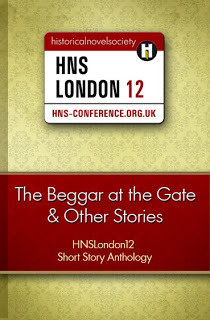
I'm delighted to announce that my story 'A Dog's Life' is featured in this wonderful anthology of short stories from the Historical Novel Society - going to press today and shortly available on Kindle. I can't wait to read my copy and all the other short stories by my fellow writers. Thanks to Carol McGrath for her hard work co-ordinating this.
My own story is set in a snowy winter in the winding streets of Restoration London near the frozen Thames. I was inspired to write the story when I read an eye-witness account about what happened to the Thames when it finally began to thaw.
Below is another wonderful book about the frozen Thames - Helen Humphreys' lovely cameos of the frozen Thames through history. And of course the frozen Thames also features in my novel 'The Gilded Lily' - currently on special offer on kindle.

Published on September 01, 2013 02:19
August 5, 2013
Winchester, Wilton Abbey and the Women of the Bayeux Tapestry
 I am delighted to welcome Carol McGrath to my blog to talk about the inspiration behind her lovely debut novel, The Hand-Fasted Wife.
I am delighted to welcome Carol McGrath to my blog to talk about the inspiration behind her lovely debut novel, The Hand-Fasted Wife. Deborah: I have to say, I just finished the book and found it to be a substantial treasure trove of historical information about the 11th century, as well as a gripping story. Edith Swan-Neck is a character with stubborn integrity who remains faithful to her hand-fasted husband despite the Norman invaders. Forced to flee to Ireland, she undergoes a series of adventures which test her courage and that of Padar, her companion. Equally suitable I would think for both a male and female readership this is a book that speaks for all those who have had to endure being exiles from their own land. It is beautifully written portrait of a more violent time and the many well-researched details bring the period lushly to life. I knew very little about this era in history, and as all the best historical fiction should, it both entertained and educated me.
I said to Carol that every schoolchild has heard of The Bayeux Tapestry, but not everyone sees the women’s stories behind it.
Carol: This is true and particularly so as The Tapestry may have been designed by Canterbury monks or a monk and possibly embroidered in several locations. Carola Hicks is one of several tapestry historians who thought it may have been embroidered at Wilton Abbey where there was a school for embroiders at this time. Various panels may have been embroidered in several locations, most probably Wilton and Canterbury. Some of the patterns for the images appear to be from The Canterbury School of Anglo-Saxon art. Others are similar to Winchester manuscript work. Queen Edith, Edward the Confessor’s wife, and Harold’s sister, was known to be one of England’s best embroiders at this time and she is very closely linked with both Winchester and Wilton Abbey. She retired to Wilton, after The Norman Conquest where as a young girl she had been educated and where during the late 1050s she had rebuilt part of the Abbey Church paralleling her husband’s work on Westminster. This explains how the first half of The Tapestry focuses on The Godwinson Story, on Harold and how the Death of King Edward has centre stage in the Tapestry.
There are three women depicted on The Tapestry. The first, a nun, being touched by a priest probably alludes to Edith’s sister who may have been an Abbess at this abbey and who allegedly was cured of blindness in the 1050s by St Edith. The second woman is thought to be Edith herself at the feet of her dying husband King Edward. Then there is the third. She is running away with her child from a burning house. At least one Tapestry historian Andrew Bridgeford thinks she could be Edith Swan-Neck, Elditha of The Handfasted Wife fleeing from her estate just before The Battle of Hastings. The little boy is considered to be Ulf, hers and King Harold’s youngest son, who was at some point in 1066 ( unknown exact date but confirmed in chronicle) taken as a hostage into Normandy and not released for decades. That information is recorded in a contemporary chronicle recounted by John of Worcester.
Thus by this theory the Godwin women do indeed appear on the Tapestry. There is, interestingly, a Wikipedia entry for Alain of Brittany (which I had not read until very recently) that suggests he first met Harold’s handfasted or common-law wife, Edith Swan-Neck, when she was held as a hostage before the Battle of Hastings in William’s camp. And I thought I had made this up!
I have great sympathy with the Tapestry embroiderers whoever they may have been because I am convinced that the Tapestry allows an English perspective and then half way through takes up the Norman perspective. It is beautifully executed and an invaluable enduring primary resource. The more one researches it the more intricate it becomes. There is layer upon layer of story, allegory, culture and history woven into it revealing life in 1065/66- hunting in peacetime-Harold is always depicted with his hawk on his wrist, feasting, and, sadly, Conquest with little details including perfect, very life-like horses and somehow it portrays the sorrow of war with its Golgotha of skeletons, importantly, not just for the men but, of course, for their widows and daughters too as the Burning House vignette shows us.
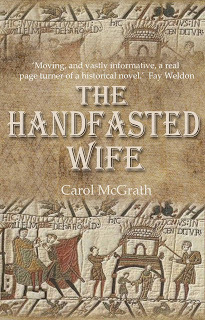
I asked Carol what it must have been like for the women undergoing these great changes.
The Eleventh Century was a pivotal time for England when all that was familiar was swept away. I try to convey how this felt for the noble women in my novel. Many women either went into sanctuary in convents. Some intermarried with Normans who sought to somehow legitimise their land-grab especially after the Pope decided to cash in and demand his cut for land taken illegitimately and those slain at Hastings. That is a complex issue that I do not have space to expand on here, but it significantly underpins why many aristocratic women went south-west with Gytha, Harold’s mother in 1066 to Exeter, her dower city, where they faced a terrible three week long siege. All this is fictionalised in The Handfasted Wife. In truth I think these women hoped that Harold’s sons and their uncle would sweep across the Irish Sea with Danish and Irish help and destroy the Conqueror but I do think they would realise by the fall of Exeter that by 1068 reversal was well-nigh impossible, too many collaborators in the south at high level. Fortunately, the women were permitted some degree of financial security, but no more spoilers. I have said enough.
How did you research the period - apart from of course using the Tapestry?
As always with historical fiction the easiest aspects to research are every-day life. My great treasure is The Bodleian Library in Oxford. I can do every day research from secondary material but I also study manuscripts and chronicles and find information from depictions on calendars and in 11th century writings such as poetry, riddles and sermons. The most difficult bit is the analysis of chronicle writings and trying to piece together how women might have thought about their life. Religion is important as the concept of religion then was very different. The church’s view generally concerning women and sin is alien. Easier is the fact that the human being has emotions that are expressed through motivation, jealousy, avarice, empathy, love, understanding and so on. The mores of the time dictates how these emotions manifest themselves. Conditions were so different that if I totally wrote the 11th century woman’s lot, not allowing any twenty-first sensibilities to creep in at all, a reader might not want to read this work of fiction. I shall save those revelations for a non-fiction book on the Women of Hastings and I guess in historical fiction there will always be a little compromise, and since it is done knowingly, that choice or selection can be very difficult.
What's next? Is there a sequel planned?
And so now I am on the final chapter of the second novel in this trilogy (The Daughters of Hastings). My new work, Countess of the North(working title) is Gunnhild’s story. She was King Harold’s younger daughter, and she really did elope from Wilton Abbey with an enemy knight. She, in time, becomes involved in a love triangle, precisely how is not clear historically. Therefore, I have used recent analysis for this story which was some years ago written up in Haskins Journal. I have translated this into a very romantic piece indeed.
Many thanks to Carol for taking the time from her final chapter to chat to me! And do check out all the great reviews for The Hand-Fasted Wife by clicking on the book.Find out more about Carol's writing here
Published on August 05, 2013 08:18
July 12, 2013
Why does a writer need four blogs?
A writer has limited time, so why would I want to commit myself to writing four blogs? Well here's why. Each blog has a function.
This blog - the one you are currently reading - is my writing blog, and on it I muse about my writing process, share technical or writing tips and reviews, and talk about my books. As you can see I have a small number of followers but they all have an interest in my books or my writing.
My second blog, Royalty Free Fiction, was designed so I could widen my contact with other writers who enjoyed writing historical fiction, but were more interested in the ordinary person than in Kings and Queens. I also hoped this would help me reach out to readers who enjoyed historical fiction, but were not so much interested in the big names. I've always had a liking for stories about the ordinary people who were caught up in the dramas of history, particularly the lost voices of those whose history does not appear in biographies. On this blog I aim to promote royalty free historical fiction in general, particularly the more literary books that are often not labelled as historical but are, nonetheless, set in the past. These are the readers and writers that I think will also enjoy my books.
My third blog, Hoydens and Firebrands, is a blog I share with others who are passionate about the 17th Century. I was invited to contribute to this blog after posting comments on the blog. It was an ideal opportunity as I was wondering how I could communicate with other people who share my love of the period, and how I could share my research and knowledge. This blog enables me to contribute to a resource which acts as an Encyclopaedia of the 17th Century from writers I can trust. My first three books are set in the 17th Century so it made sense to try to reach readers and writers with the same interests.
 My fourth blog, English Historical Fiction Authors, run by Debra Brown and MM Bennetts, embraces posts from anyone anywhere in the world with an interest in English History. This blog has by far the biggest number of followers, and I hope that my posts will reach lovers of historical fiction whatever their particular interest. This community of bloggers also has a facebook page and through this we can make sure a post appears every day. An anthology of our essays and posts will be available in book form on 23rd September - Castles, Customs and Kings.
My fourth blog, English Historical Fiction Authors, run by Debra Brown and MM Bennetts, embraces posts from anyone anywhere in the world with an interest in English History. This blog has by far the biggest number of followers, and I hope that my posts will reach lovers of historical fiction whatever their particular interest. This community of bloggers also has a facebook page and through this we can make sure a post appears every day. An anthology of our essays and posts will be available in book form on 23rd September - Castles, Customs and Kings.
I like to think of the four blogs as nesting Russian Dolls with my own blog at the centre with its narrow range of interest, which then widens through the other blogs to the general community of lovers of historical fiction: my own books - books about the 17thC - historical books about ordinary people - historical fiction of all types.
 So how do I find the time?
So how do I find the time?
On this blog, I simply post when I have the time and when I am inspired to share something. Royalty Free Fiction, I post when another writer shares or wants to promote their Royalty Free book with me - if you'd like to post please get in touch via the blog! Hoydens and Firebrands, I post once a month. Look out for me on Sunday. English Historical Fiction Authors, I post once a month, my post is up today.
I'd like to stress that for me blogging is not only about promotion, though I hope it gives people access to news about my books. A lot of it is about finding communities in which I can play a part (albeit a small one.) I have made many great contacts through blogging, and like to read the posts of my fellow bloggers who share my interests.
Four blogs? Well, it works for me.
This post summarises an input I gave on a panel at the Historical Novel Society Conference - the people on the panel were all people I had met online through blogging.
Thanks to my fellow pannellists : Heather Rieseck, Heather Webb, Julianne Douglas and Amy Bruno.
I enjoy guests on my blog, please contact me if you'd like to guest.
This blog - the one you are currently reading - is my writing blog, and on it I muse about my writing process, share technical or writing tips and reviews, and talk about my books. As you can see I have a small number of followers but they all have an interest in my books or my writing.
My second blog, Royalty Free Fiction, was designed so I could widen my contact with other writers who enjoyed writing historical fiction, but were more interested in the ordinary person than in Kings and Queens. I also hoped this would help me reach out to readers who enjoyed historical fiction, but were not so much interested in the big names. I've always had a liking for stories about the ordinary people who were caught up in the dramas of history, particularly the lost voices of those whose history does not appear in biographies. On this blog I aim to promote royalty free historical fiction in general, particularly the more literary books that are often not labelled as historical but are, nonetheless, set in the past. These are the readers and writers that I think will also enjoy my books.
My third blog, Hoydens and Firebrands, is a blog I share with others who are passionate about the 17th Century. I was invited to contribute to this blog after posting comments on the blog. It was an ideal opportunity as I was wondering how I could communicate with other people who share my love of the period, and how I could share my research and knowledge. This blog enables me to contribute to a resource which acts as an Encyclopaedia of the 17th Century from writers I can trust. My first three books are set in the 17th Century so it made sense to try to reach readers and writers with the same interests.
 My fourth blog, English Historical Fiction Authors, run by Debra Brown and MM Bennetts, embraces posts from anyone anywhere in the world with an interest in English History. This blog has by far the biggest number of followers, and I hope that my posts will reach lovers of historical fiction whatever their particular interest. This community of bloggers also has a facebook page and through this we can make sure a post appears every day. An anthology of our essays and posts will be available in book form on 23rd September - Castles, Customs and Kings.
My fourth blog, English Historical Fiction Authors, run by Debra Brown and MM Bennetts, embraces posts from anyone anywhere in the world with an interest in English History. This blog has by far the biggest number of followers, and I hope that my posts will reach lovers of historical fiction whatever their particular interest. This community of bloggers also has a facebook page and through this we can make sure a post appears every day. An anthology of our essays and posts will be available in book form on 23rd September - Castles, Customs and Kings.I like to think of the four blogs as nesting Russian Dolls with my own blog at the centre with its narrow range of interest, which then widens through the other blogs to the general community of lovers of historical fiction: my own books - books about the 17thC - historical books about ordinary people - historical fiction of all types.
 So how do I find the time?
So how do I find the time?On this blog, I simply post when I have the time and when I am inspired to share something. Royalty Free Fiction, I post when another writer shares or wants to promote their Royalty Free book with me - if you'd like to post please get in touch via the blog! Hoydens and Firebrands, I post once a month. Look out for me on Sunday. English Historical Fiction Authors, I post once a month, my post is up today.
I'd like to stress that for me blogging is not only about promotion, though I hope it gives people access to news about my books. A lot of it is about finding communities in which I can play a part (albeit a small one.) I have made many great contacts through blogging, and like to read the posts of my fellow bloggers who share my interests.
Four blogs? Well, it works for me.
This post summarises an input I gave on a panel at the Historical Novel Society Conference - the people on the panel were all people I had met online through blogging.
Thanks to my fellow pannellists : Heather Rieseck, Heather Webb, Julianne Douglas and Amy Bruno.
I enjoy guests on my blog, please contact me if you'd like to guest.
Published on July 12, 2013 02:54
June 27, 2013
A fresh approach to writing what you know - get away!
 I've just been to Florida for the Historical Novel Conference. Apart from being able to attend wonderful sessions on all aspects of writing historical fiction, it was also a chance for me to go somewhere completely different and take in another landscape from the one which I look at every day.
I've just been to Florida for the Historical Novel Conference. Apart from being able to attend wonderful sessions on all aspects of writing historical fiction, it was also a chance for me to go somewhere completely different and take in another landscape from the one which I look at every day.Florida is flat, sunny and riddled with water - lakes, rivers and creeks. The roads are wide, level and straight and everyone cruises in big cars at fast speeds. The palm trees sway in breezes or sometimes hurricane style winds. Buildings are low and spread wide apart with no fences between the gardens. Crows and squirrels are skinny; they don't need much fat to keep them warm as the air there is hot and moist.
This is totally different from my English landscape. Where I live, the sky is smaller, framed by hills. Blue skies are a rarity and the roads are narrow, winding and banked by clusters of stone cottages. Today as I look out of my window a fine mist is drifting from the sky putting a damp veil over everything. The sky is almost colourless, a uniform white/grey as if it is illuminated like paper from behind.
One of the things I enjoyed about Florida was that it gave me (even if only for a few days) the chance to look at England through a stranger's eyes. And a stranger's eyes are what a novelist needs to bring freshness to the page. It is easy to forget that I have readers in other parts of the world who will read 'in the front garden' as something quite different from my intended version.
If you can't actually get away, then anything that gives you a new perspective will work just as well to invigorate your writing. Who could fail to look at life a little differently after viewing Salvador Dali's take on life? Hard things are suddenly mutable, furniture needs to be propped up by crutches, time bends and turns back on itself.
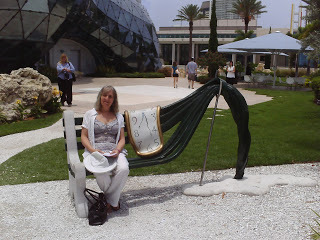 Outide the wonderful Salvador Dali Museum in St Petersburg
Outide the wonderful Salvador Dali Museum in St Petersburg
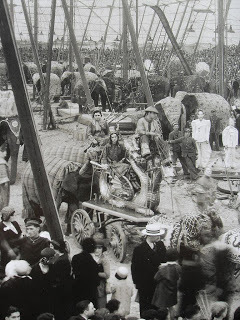 Picture from www.circusnospin.blogspot.comAt the Ringling Museum the sheer scale of a 19th century circus made me gasp in astonishment. One man had dedicated himself to telling the story of 'a day in the life of the circus' through his models, painstakingly made over a lifetime. In this world in miniature I was able to see that Ringling's travelling circus typically housed 1000 people, more than 300 horses and zebras, 80 to 100 musicians, 300 circus and hippodrome performers, 100 cages, plus the dens, chariots,and so forth that would parade through the town to raise interest in the performance.
Picture from www.circusnospin.blogspot.comAt the Ringling Museum the sheer scale of a 19th century circus made me gasp in astonishment. One man had dedicated himself to telling the story of 'a day in the life of the circus' through his models, painstakingly made over a lifetime. In this world in miniature I was able to see that Ringling's travelling circus typically housed 1000 people, more than 300 horses and zebras, 80 to 100 musicians, 300 circus and hippodrome performers, 100 cages, plus the dens, chariots,and so forth that would parade through the town to raise interest in the performance.[image error] Howard's scale model
 Ringling Museum - courtesy of TripadvisorA novel that takes advantage of this setting is 'Water for Elephants' by Sara Gruen, but even this cannot convey the enormous scale of the 19th century circus. After seeing this exhibit, train travel back to my home in England seemed easy. What, no elephants to transport? No need to keep an eye on the lions or send a crew ahead with the thirty yard tent that needs putting up before anyone can eat? More info on the circus
Ringling Museum - courtesy of TripadvisorA novel that takes advantage of this setting is 'Water for Elephants' by Sara Gruen, but even this cannot convey the enormous scale of the 19th century circus. After seeing this exhibit, train travel back to my home in England seemed easy. What, no elephants to transport? No need to keep an eye on the lions or send a crew ahead with the thirty yard tent that needs putting up before anyone can eat? More info on the circus Ford Edison Estate courtesy of Tripadvisor.com
Ford Edison Estate courtesy of Tripadvisor.comWhilst in Florida we travelled from beaches to cities, always with a museum or two in mind. Highlights for us were the Ringling Museum and the Ford Edison Country Estate.

Whilst visiting the Titusville Museum, run by a bunch of enthusiasts for their local history, I came across this lovely little second-hand bookshop and had a conversation with the owner about Deborah Harkness's new book. If you are near Titusville, do go check out the shop, The Book Rack, it has a great selection of Historical Fiction and Historical Romance.
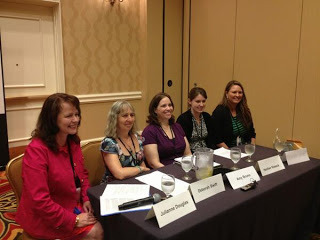
Before signing off this post, I must mention fellow historical fiction bloggers who were on my panel at the conference; Circus drumroll please!
Julianne Douglas
Heather Webb
Heather Rieseck
Amy Bruno
I had a fabulous time in Florida, came back refreshed and renewed and itching to get back to my writing.
Published on June 27, 2013 11:02
June 14, 2013
Blogging at the Historical Novel Society Conference, Florida
I will be speaking at the Conference on the panel entitled Virtual Salon: The Historical Fiction BlogToday’s readers (and publishers) expect authors to have an internet presence. A blog is an effective way to join the writer, reader, and reviewer of historical fiction in dynamic interaction about novels and the history that infuses them. This panel at the conference will not only examine the benefits an author derives from maintaining a blog at various stages of her career, but will explore how blogging serves the historical fiction community as a whole. Topics include: finding a niche and establishing a voice; effective blogging strategies (regular features, guest posts, contests, blog tours); blogging etiquette; expanding one’s audience; and measuring success.
I thought it would be nice to introduce you to my fellow-panellists on the 'Virtual Salon' panel at the Conference. We have only ever met 'virtually' so it will be lovely to meet them in real life. Click on their pictures to be taken to their blogs!
 Julianne Douglas has been organising us all for our panel discussion, and wrote the blurb at the top of this post. Julianne's blog 'Writing the Renaissance' focusses on historical fiction set in sixteenth century France. An avid reader who fell in love with all things French at the age of twelve, she went on to earn a Ph.D in French literature from Princeton.
Julianne Douglas has been organising us all for our panel discussion, and wrote the blurb at the top of this post. Julianne's blog 'Writing the Renaissance' focusses on historical fiction set in sixteenth century France. An avid reader who fell in love with all things French at the age of twelve, she went on to earn a Ph.D in French literature from Princeton.

Heather Webb's novel, 'Becoming Josephine' will be published in 2014 by Penguin/Plume and her blog 'Between the Sheets' is about her writing and publishing journey.

Amy Bruno's blog 'Passages to the Past' is a long-standing blog for the historical fiction community reviewing books of all periods and she boasts over 1000 followers and 418 networked blogs. Amy also runs the Historical Fiction Virtual Book Tours.

Heather Rieseck started her blog, 'The Maiden's Court' in 2009 as an outlet for her reading. It has since become well-known for its honest reviews of historical novels and her author interviews.
Please consider checking out the blogs and leaving a comment. If there is anything you would like to know about blogging and historical fiction, please leave me a comment so that I can flag it up for the panel. We are looking forward to a great discussion and look out for my report of the session on this blog.
I thought it would be nice to introduce you to my fellow-panellists on the 'Virtual Salon' panel at the Conference. We have only ever met 'virtually' so it will be lovely to meet them in real life. Click on their pictures to be taken to their blogs!
 Julianne Douglas has been organising us all for our panel discussion, and wrote the blurb at the top of this post. Julianne's blog 'Writing the Renaissance' focusses on historical fiction set in sixteenth century France. An avid reader who fell in love with all things French at the age of twelve, she went on to earn a Ph.D in French literature from Princeton.
Julianne Douglas has been organising us all for our panel discussion, and wrote the blurb at the top of this post. Julianne's blog 'Writing the Renaissance' focusses on historical fiction set in sixteenth century France. An avid reader who fell in love with all things French at the age of twelve, she went on to earn a Ph.D in French literature from Princeton.
Heather Webb's novel, 'Becoming Josephine' will be published in 2014 by Penguin/Plume and her blog 'Between the Sheets' is about her writing and publishing journey.

Amy Bruno's blog 'Passages to the Past' is a long-standing blog for the historical fiction community reviewing books of all periods and she boasts over 1000 followers and 418 networked blogs. Amy also runs the Historical Fiction Virtual Book Tours.

Heather Rieseck started her blog, 'The Maiden's Court' in 2009 as an outlet for her reading. It has since become well-known for its honest reviews of historical novels and her author interviews.
Please consider checking out the blogs and leaving a comment. If there is anything you would like to know about blogging and historical fiction, please leave me a comment so that I can flag it up for the panel. We are looking forward to a great discussion and look out for my report of the session on this blog.
Published on June 14, 2013 08:42



